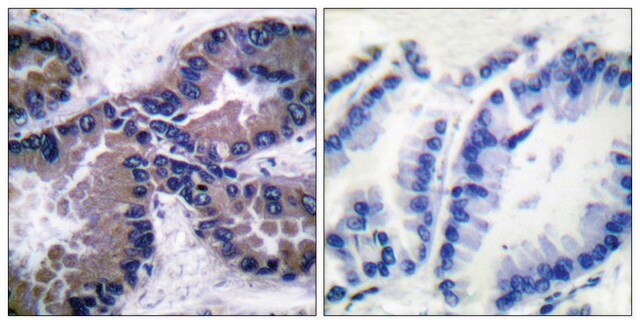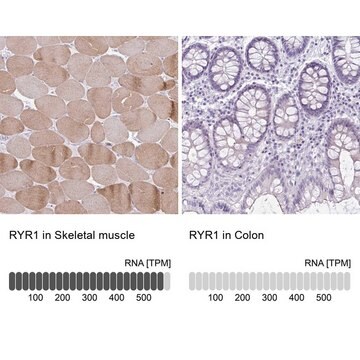R129
Monoclonal Anti-Ryanodine Receptor antibody produced in mouse
clone 34C, ascites fluid
Sinonimo/i:
Anti-CCO, Anti-KDS, Anti-MHS, Anti-MHS1, Anti-PPP1R137, Anti-RYDR, Anti-RYR, Anti-RYR-1, Anti-SKRR
About This Item
IHC (f)
IP
WB
immunohistochemistry (frozen sections): 1:1,000
immunoprecipitation (IP): suitable
western blot: 1:5,000
Prodotti consigliati
Origine biologica
mouse
Livello qualitativo
Coniugato
unconjugated
Forma dell’anticorpo
ascites fluid
Tipo di anticorpo
primary antibodies
Clone
34C, monoclonal
PM
antigen 565 kDa (non-mammalian vertebrates, doublet at 565 kDa representing the α and β isoforms)
Reattività contro le specie
human, rat, rabbit, canine, mink, bovine, frog, fish, primate, chicken, mouse, sheep
tecniche
direct immunofluorescence: suitable
immunohistochemistry (frozen sections): 1:1,000
immunoprecipitation (IP): suitable
western blot: 1:5,000
Isotipo
IgG1
N° accesso UniProt
Condizioni di spedizione
dry ice
Temperatura di conservazione
−20°C
modifica post-traduzionali bersaglio
unmodified
Informazioni sul gene
human ... RYR1(6261) , RYR2(6262)
mouse ... Ryr1(20190) , Ryr2(20191)
rat ... Ryr1(114207) , Ryr2(84025)
Descrizione generale
Immunogeno
Applicazioni
Western Blotting (1 paper)
Stato fisico
Esclusione di responsabilità
Non trovi il prodotto giusto?
Prova il nostro Motore di ricerca dei prodotti.
Codice della classe di stoccaggio
10 - Combustible liquids
Classe di pericolosità dell'acqua (WGK)
nwg
Punto d’infiammabilità (°F)
Not applicable
Punto d’infiammabilità (°C)
Not applicable
Dispositivi di protezione individuale
Eyeshields, Gloves, multi-purpose combination respirator cartridge (US)
Scegli una delle versioni più recenti:
Possiedi già questo prodotto?
I documenti relativi ai prodotti acquistati recentemente sono disponibili nell’Archivio dei documenti.
Il team dei nostri ricercatori vanta grande esperienza in tutte le aree della ricerca quali Life Science, scienza dei materiali, sintesi chimica, cromatografia, discipline analitiche, ecc..
Contatta l'Assistenza Tecnica.




